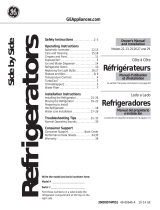
Installation Instructions
INSTALLING THE REFRIGERATOR
REFRIGERATOR LOCATION
• Do not install the refrigerator where the temperature
will go below 60°F (16°C) because it will not run often
enough to maintain proper temperatures.
• Do not install the refrigerator where the temperature
will go above 100°F (37°C) because it will not perform
properly.
• Do not install the refrigerator in a location exposed to
water (rain, etc.) or direct sunlight.
• Install it on a floor strong enough to support it fully
loaded.
CLEARANCES
For clearance for ease of installation, proper air
circulation and plumbing and electrical, please refer to
the rating plate on the top left wall of the refrigerator.
CONNECTING THE REFRIGERATOR
TO THE HOUSE WATER LINE
(icemaker models)
A cold water supply is required for automatic
icemaker operation. If there is not a cold water
supply, you will need to provide one. See Installing
the Water Line section.
NOTES:
• Before making the connection to the refrigerator,
be sure the refrigerator power cord is not plugged
into the wall outlet.
• If your refrigerator does not have a water filter,
we recommend installing one if your water supply
has sand or particles that could clog the screen of
the refrigerator’s water valve. Install it in the water
line near the refrigerator. If using SmartConnect
™
Refrigerator Tubing Kit, you will need an additional
tube (WX08X10002) to connect the filter. Do not cut
plastic tube to install filter.
1
REMOVE TOP CAP (on some models)
•
IMPORTANT NOTE: This refrigerator is 34-1/2” deep.
Doors and passageways leading to the installation
location must be at least 36” wide in order to leave
the doors and handles attached to the refrigerator
while transporting it into the installation location. If
passageways are less than 36”, the refrigerator doors
and handles can easily be scratched and damaged.
The top cap and doors can be removed to allow the
refrigerator to be safely moved indoors. Start with Step A.
• If it is not necessary to remove doors, skip Step A.
Leave tape and all packaging on doors until the
refrigerator is in the final location.
• SKID REMOVAL: Tilt refrigerator to each side to
remove skid.
• NOTE: Use a padded hand truck to move this
refrigerator. Place the refrigerator on the hand truck
with a side against the truck. We strongly recommend
that TWO PEOPLE move and complete this installation.
Locate and remove the two Phillips head screws on
the top of the refrigerator. Remove the two screws
on each side at the rear of the top cap. Lift off and
remove top cap.
Remove the fresh-food door(s). Refer to Steps 1 and 3
of “Reversing the Door Swing” section or Steps 1 and
2 of “Removing the Doors” section.
Remove the bottom freezer drawer or door. Refer
to “Removing Freezer Drawer” section or Step 2 of
“Reversing the Door Swing” section.
Move refrigerator to the installation location.
A
B
C
D
15
REMOVE TOP CAP (cont.)
(on some models)
REINSTALL DOORS, DRAWERS AND TOP CAP
Carefully lower the door(s) onto the center
hinge(s). Reinstall top hinge(s). NOTE: Ensure
the door is properly aligned to the case top to
avoid readjustment of the door during top cap
reinstallation.
Place cap over the top of the refrigerator. Reinstall
the original screws in the top and back of the cap.
Reinstall the bottom freezer drawer or door. Refer to
“Replacing the Freezer Drawer” section or Step 8 of
“Reversing the Door Swing” section.
E
F
G
A
Top Hinge B




















